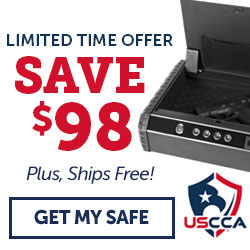The bag- This is the part that tends to change the most from person to person. Some like small bags, some like big bags, but none the less you need a bag that is durable, portable, and compartmentalized. The pictured bag in this post is our ASO Bag. This is considered a larger than normal Go Bag and would be designed to fit more in a trunk than at your feet. Not sure where to buy a bag? No problem, everyone carries the go bag that they swear is the perfect design. The bottom line is figuring out what works best for you and your mission that can carry all of your goods but still be portable and efficient.
Extra Ammunition- You can never have too many bullets in a firefight, and your Go Bag is the perfect place to store extra ammo. It is wise to carry ammo for your most casualty producing weapons such as your M-4, Shotgun (police), or Crew Serve Weapon but remember to store a few extra mags for any other weapon systems you might have on you. If your primary goes down, you want to have a few extra mags for your secondary. I like to carry an extra load of ammo of 8xM4 mags, and 3xG17 9mm mags. Also I store magazines in the doors, glove compartments and any other available space in any vehicle I am in.
Hand Grenades- These things are powerful and can change who is Mr. Awesome in a firefight in a snap. One or two in a Go Bag can go a long way. Don’t have access to hand grenades? Flash Bangs are also helpful in at least increasing your violence of action.
Medical Equipment- This doesn’t need to be a portable trauma center, but you should have enough essentials on hand to tend to 3-4 wounded personnel. Remember to carry equipment to treat what injuries you would most likely see like tourniquets, chest seals and needle decompression needles, NPAs, packs of gauze, coagulating agents and a few transformer bandaids for the guy that complains about his boo boo. Carrying some 9 Line MEDEVAC format is also a good idea and essential for getting the Helicopters in the air. REFT carries MEDEVAC stickers for your weapon, radio or Go Bag at refactortactical.com Keep in mind these are only suggestions (from a bunch of knuckle draggers), and you should go to your combat medic or healthcare provider for a detailed list of what to carry and how to use it.
Batteries- Optics, flashlights, IR Strobes, NVGs, GPSs, laser designators, radios, cell phones, and iPods are all electronics that will go out when you need them the most. Be sure to go through your kit and find anything that requires batteries or a charge and bring a way to replenish it. Putting batteries on the back of your helmet is another great way to store them and helps to balance out your NVGS a little bit. The bottom line is you can never have too many batteries or change them out enough to ensure that your electronics will be working when you need them the most.
Water- Kind of a no-brainer. This is especially important if you might need to E&E through some drought-rode shit hole sandbox. While water bladders can carry a lot of liquid, they also break easily. Nalgenes, on the other hand, are durable and can also carry whiskey if your mission turns into a party later on… Or for use with Iodine tablets, potato I guess. At the very least carry enough water to last you through a good movement and remember this is the water you only touch in an emergency.
Iodine Tablets– These things are for when the above runs out, and you need to replenish. While a water pump will taste better, these tend to be more portable.
American/UK/German/Australian/Whatever country you work for Flag- When the going gets tough, it’s always good to have some identification. This can help the friends determine if you are the foe or not and is especially important when operating undercover.
Signal Kit- Always have the ability to mark your location with big bright and shiny things. A good signaling kit should include a VF-17 panel or bright orange marking (hunter orange works as well), colored smoke, IR panel, pen flare or star cluster, and an IR strobe. Remember to think P.A.C.E (Primary, Alternate, Contingency, and Emergency) when coming up with your signal plan.
Emergency Commo- Even though you carry a radio and most likely a super sweet iPhone you should also consider some emergency commo plan. As with signaling, you should come up with a P.A.C.E for communications. Things like Sat phones, local cell phones, emergency radios, and cans with string on them are always a plus when your primary means of commo doesn’t work (as it most likely won’t). Be sure to get with your commo guy and listen to his excuses about how he can’t make comms because of the sunspots and misalignment of the moon to the planets is messing him up. He should be able to explain to you how all of your equipment works.
Food- Like water this stuff keeps you going during long movements. You don’t need anything substantial like a full MRE or enough food for 3 square meals. Instead, choose things that will help keep you going during an E&E like protein bars and power gels.
Survival Kit- Again don’t make this be anything crazy but be sure to have enough stuff to help you out if you have to rough the elements for a few days.
Items could include: 550 cord, duct tape, fire starters (matches and a lighter), wire, pocket knife, salt and sugar or Oral Rehydration Salts, Map of the Area, compass, handcuff key, lock pic (bobby pins work well), fishing line and hook, pencil and notepad, and a plant and animal ID guide. 550 Cord Operator Bands like the ones sold at refactortactical.com are also great for keeping much-needed cord on you for anything from setting a snare to tying up officers who have “a very good idea.”
Flashlight- So you can see things when it’s dark. Flashlights can also be an effective means of signaling for help or recovery.
Again these are all suggestions, and each individual should tailor each bag for their needs.
Have more ideas or comments on what to put in a Go Bag? Post them below; we always appreciate your opinions!









Leave a Reply
Your email address will not be published. Required fields are marked *